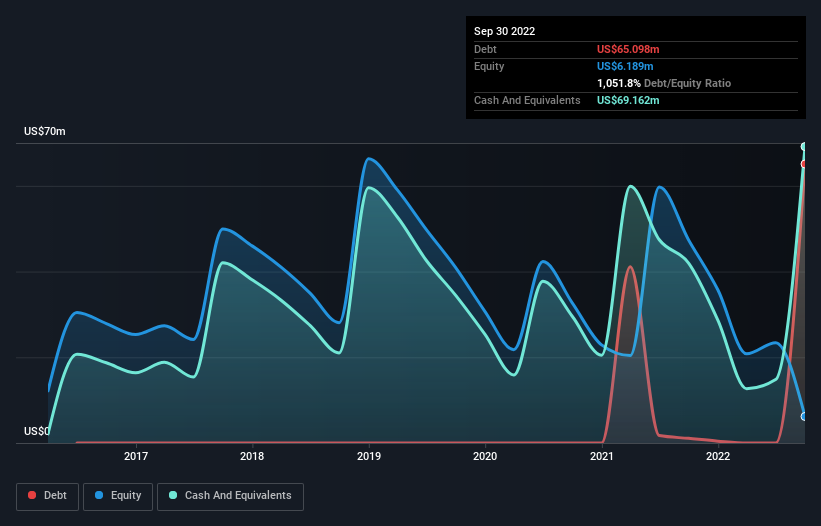- United States
- /
- Medical Equipment
- /
- NasdaqCM:PLSE
Pulse Biosciences (NASDAQ:PLSE) Has Debt But No Earnings; Should You Worry?
Some say volatility, rather than debt, is the best way to think about risk as an investor, but Warren Buffett famously said that 'Volatility is far from synonymous with risk.' So it might be obvious that you need to consider debt, when you think about how risky any given stock is, because too much debt can sink a company. We note that Pulse Biosciences, Inc. (NASDAQ:PLSE) does have debt on its balance sheet. But the more important question is: how much risk is that debt creating?
When Is Debt Dangerous?
Debt assists a business until the business has trouble paying it off, either with new capital or with free cash flow. In the worst case scenario, a company can go bankrupt if it cannot pay its creditors. However, a more common (but still painful) scenario is that it has to raise new equity capital at a low price, thus permanently diluting shareholders. By replacing dilution, though, debt can be an extremely good tool for businesses that need capital to invest in growth at high rates of return. The first thing to do when considering how much debt a business uses is to look at its cash and debt together.
View our latest analysis for Pulse Biosciences
How Much Debt Does Pulse Biosciences Carry?
As you can see below, at the end of September 2022, Pulse Biosciences had US$65.1m of debt, up from US$1.09m a year ago. Click the image for more detail. However, it does have US$69.2m in cash offsetting this, leading to net cash of US$4.06m.

How Strong Is Pulse Biosciences' Balance Sheet?
We can see from the most recent balance sheet that Pulse Biosciences had liabilities of US$7.00m falling due within a year, and liabilities of US$74.4m due beyond that. Offsetting these obligations, it had cash of US$69.2m as well as receivables valued at US$5.0k due within 12 months. So its liabilities outweigh the sum of its cash and (near-term) receivables by US$12.2m.
Of course, Pulse Biosciences has a market capitalization of US$108.7m, so these liabilities are probably manageable. Having said that, it's clear that we should continue to monitor its balance sheet, lest it change for the worse. Despite its noteworthy liabilities, Pulse Biosciences boasts net cash, so it's fair to say it does not have a heavy debt load! When analysing debt levels, the balance sheet is the obvious place to start. But it is future earnings, more than anything, that will determine Pulse Biosciences's ability to maintain a healthy balance sheet going forward. So if you're focused on the future you can check out this free report showing analyst profit forecasts.
Over 12 months, Pulse Biosciences reported revenue of US$1.6m, which is a gain of 171%, although it did not report any earnings before interest and tax. So there's no doubt that shareholders are cheering for growth
So How Risky Is Pulse Biosciences?
We have no doubt that loss making companies are, in general, riskier than profitable ones. And in the last year Pulse Biosciences had an earnings before interest and tax (EBIT) loss, truth be told. Indeed, in that time it burnt through US$52m of cash and made a loss of US$65m. Given it only has net cash of US$4.06m, the company may need to raise more capital if it doesn't reach break-even soon. The good news for shareholders is that Pulse Biosciences has dazzling revenue growth, so there's a very good chance it can boost its free cash flow in the years to come. High growth pre-profit companies may well be risky, but they can also offer great rewards. When analysing debt levels, the balance sheet is the obvious place to start. However, not all investment risk resides within the balance sheet - far from it. For instance, we've identified 4 warning signs for Pulse Biosciences that you should be aware of.
When all is said and done, sometimes its easier to focus on companies that don't even need debt. Readers can access a list of growth stocks with zero net debt 100% free, right now.
New: Manage All Your Stock Portfolios in One Place
We've created the ultimate portfolio companion for stock investors, and it's free.
• Connect an unlimited number of Portfolios and see your total in one currency
• Be alerted to new Warning Signs or Risks via email or mobile
• Track the Fair Value of your stocks
Have feedback on this article? Concerned about the content? Get in touch with us directly. Alternatively, email editorial-team (at) simplywallst.com.
This article by Simply Wall St is general in nature. We provide commentary based on historical data and analyst forecasts only using an unbiased methodology and our articles are not intended to be financial advice. It does not constitute a recommendation to buy or sell any stock, and does not take account of your objectives, or your financial situation. We aim to bring you long-term focused analysis driven by fundamental data. Note that our analysis may not factor in the latest price-sensitive company announcements or qualitative material. Simply Wall St has no position in any stocks mentioned.
About NasdaqCM:PLSE
Flawless balance sheet with low risk.
Market Insights
Community Narratives



